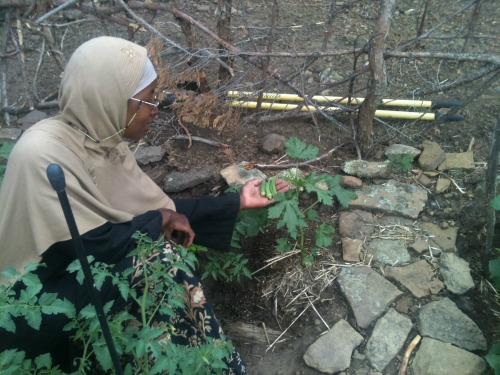Part 2 of a series of dispatches from a former DC area resident homesteading in the Colorado mountains

There's a restlessness coming. A twitchy waiting. A tapping of fingers and brief, quivery sighs. Skittish little thoughts play about like leaves on puffs of wind. Anticipation...the spring seed catalogs are soon to arrive.
Now, most folks wait feverishly this time of year for their IRS checks to arrive, visions of new cars and shopping sprees at Target temporarily arresting their common sense. But homesteaders, we're banking on those oversized, glossy-paged, full color seed catalogs where every page is a major ad campaign for lusty and vibrant blemish-free vegetation.
Voluptuous heads of broccoli vie with bold statuesque carrots confidently displaying enticing orange-red hues. Verdant peppers defy you to look away at the pouty little strawberries glistening for your attention. And then there's the tomato section, a mini-volume unto itself. Page upon technicolor page of extra-earlies, mid-seasons, slicing, paste, cherries and beefsteaks in a mind-numbing panoply of shades from palest vanilla, bright gold, ruby and scarlet, rich purple, leaf green, chocolate brown, and some even striped or spotted. It's enough of an overload to put a gardener in veggie rehab.
To city-dwellers, seed catalogs are most likely junk mail, to be conscientiously consigned to the paper recycling bin. But to those of us outside the city limits they are little books of promise, aspiration, dare I say, ambition. Each page, each new variety offers the allure of new colors in the garden, original flavors on the palate, more cultivation knowledge to add to our homesteading skills. Sure, we may have planted Provider and Blue Lake green beans last year, reliable standards in the garden, but this spring we may step up to the exotic Dragon's Tongue variety. Last year, Black Beauty zucchini. This year, maybe the Zappa del Tronco.

But one thing never changes: always heirloom, open-pollinated, non-GMO seeds. Here's why. Heirlooms are seeds that were in circulation before World War II prior to the introduction of F-1 hybrid seeds and all their attendant big agri-business tamperings. Heirloom seeds grow plants that are “true to the parent”, like having kids from you and your spouse, directly. F-1 hybrid seeds are a cross of two different varieties of a plant, so they're like a third cousin's half-brother's kids on your mama's side. Technically they're related and fully functional, but they may not turn out like anybody else in the family. And GMO's? Well, let's just say they're like a mad scientist's test tube babies, so just close that door and walk away.

Allah Subhaanah wa T'ala in His mercy and wisdom gave us everything we need to nourish ourselves in these little seeds. But He also warns us in Surat an-Nisa that shaytaan said: “Verily, I will mislead them...and indeed I will order them to change the creation of Allah...” So shaytaan gets all up in the agricultural mix and now you've got seed companies designing tomatoes with salmon genes inserted into them so they'll withstand the rigors of cold shipping and storage. Or apples that don't get brown after you cut them so they can look perfectly perfect for waaay longer than is naturally natural. What's next? Crossing cucumbers with firefly genes so they'll glow in the dark and you can find them in the depths of your salad? A'udhu billaah.
If your kids are anything like my daughter Atiyya they may not jump into their overalls, grab the family pitchfork and race you to the garden. Atiyya was only slightly less than impressed with our garden given that it was in the early stages of growth and therefore only slightly more than unimpressive. But she dutifully hauled her watering can and doused the okra and tomatoes. Unfortunately neither of these would ever pass her lips without some serious monetary coercion. However, she was beginning to learn a vital life skill: how to grow her own food.

In actuality, we don't really grow food, Allah does. He says in Surat ul-Waqi'a, “Tell me! The seed that you sow in the ground, is it you that make it grow or are We the grower?” You and I take the seed that He provides, plop it into the soil that He provides, give it the water that He provides, and then we just basically nurture it and monitor its progress to harvest. We are babysitters. In overalls.
Do yourself a favor. Do your kids a favor. Plant something. Anything. Preferably something that they will actually eat. Ever ask your kid where milk and vegetables come from? Your child looks at you blankly, then the little brain re-boots and he or she blurts out enthusiastically, “Safeway!” Now, we're not suggesting you turn your cul-de-sac into a cattle ranch, but you can tuck a seed into some soil and grow something together. Teach your child, and yourself, about the ni'mah Allah T'ala puts into a seed; how Allah provides for us from places we would never expect; the mercy in the variety of foods He gives us. Don't have a yard? You don't need one. You'd be surprised how many cucumbers or peppers you can grow in a 5-gallon bucket on your balcony, or patio, or back steps. Start a community garden. Make a homeschool project. Get some dirt under your nails and connect with Allah's earth. Grow your own little Garden of Eatin'.